How do you eat in Italian, that’s a question that’s on everyone’s mind when they visit, and when they’re back home.
Italian food culture is probably very different from what you’re used to at home. And, since Italians have been perfecting it for over 1,000 years, try going with the wine and olive oil flow instead of fighting against the current when you’re in Italy. So, while in Italy, keep in mind that both the tradition of food and eating are important parts of the culture.
But how do you say “eat” in Italian? The verb for it is “mangiare”, and if someone says “hai mangiato” it means they’re asking if you’ve eaten, and if your answer is “no”, they’ll worry and follow up with “vuoi mangiare?” which stands for “do you want to eat?”.
So here you go on a journey to learn how to eat Italian food and how to eat in Italian, exactly what we’re here to save you from some embarrassing moments by teaching you how to eat Italian food. I’ll be honest I’m still trying to understand what time Italians eat dinner, but for now…
How do you eat in Italy?
1. Eat in Italian. Don’t ask for “fettuccine alfredo” or “spaghetti with meatballs”
They don’t exist here. Alfredo is an Italian name, and when I asked my Florentine friends if they really had never heard of “fettuccine alfredo,” they responded: “Chi?” (Who?). To get pasta with cream sauce, try anyone with panna (cream) listed in the ingredients – just know that you’ll never find pollo (chicken) on that same list. Explaining the idea of putting chicken in pasta provokes confused looks and expressions like, “Che schifo!” (How disgusting!). Likewise, spaghetti is not served with meatballs. In Naples, you’ll find miniature ones on other types of pasta. Everywhere else, pasta al ragù (with meat sauce) is a common first course, and “polpette” (meatballs), are a typical – separate – second course. If you’re way ahead of me and already thinking, “I’ll just ask for both those things and mix them together,” you can certainly do that. But…reread the title of this article first.
2. What to drink with a meal
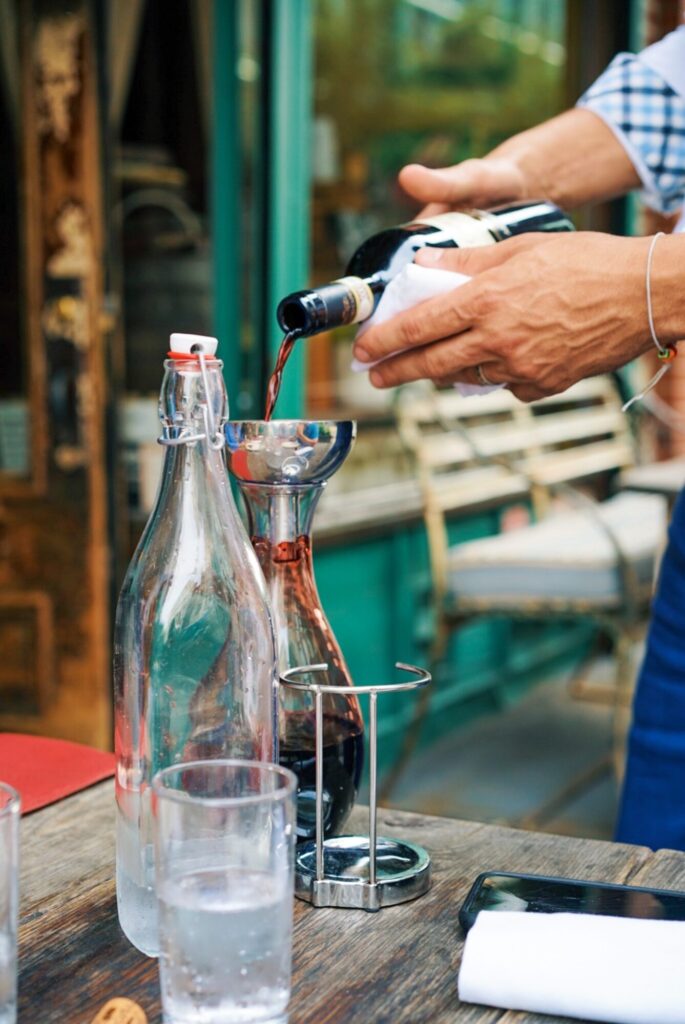
Italians only drink water, juices, sodas, wine and beer while eating. In America, my mom used to open up the fridge come dinnertime and list every drinkable thing inside: “Ok, we’ve got ginger ale, milk, coke, lemonade, Bacardi breezers…what do you want?” This would never happen in Italy. The table is usually set with a bottle of sparkling or still water, and a bottle of wine, red for meat and white for fish. Cocktails and liquors are reserved for: aperitivi (before-dinner drinks) and digestivi (after-dinner drinks). Italians take enjoying the flavor of food very seriously, and you must admit that drinking peach iced tea with rosemary lamb chops has to mess with your taste buds. One exception is pizza, to which Coke and beer are common and beloved drinks that usually accompany it.
3. Don’t eat eggs in the morning
The quintessential Italian breakfast is a strong espresso and a sweet pastry. A glass of milk or orange juice can be added. Mix up some scrambled eggs to start your day, and your Italian roommates will watch as if you’re building a spaceship on their stovetop. In Italy, eggs are usually consumed for lunch or dinner, eaten hard-boiled in a salad or sandwich, or as a frittata (open-faced omelet). If you’re dying for a salty breakfast, try a ham and cheese toast (you guessed it, a toasted sandwich) at a local bar (in Italy, a café is called a “caffè“ or “bar”), or escape to American paradise. One of the best places for an American breakfast or brunch is Rooster Café.
Location 1 – Via di Sant’Edigio 37/R
Location 2 – Via di Porta Rossa 63/R
Open Tuesday-Sunday from 9am to 3pm.
4. Do drink cappuccino in the morning
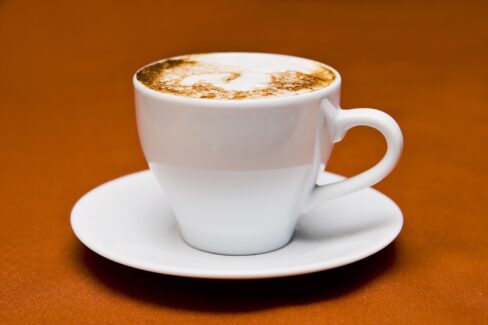
…with your (non-egg) breakfast, and not as an accompaniment or finish to other meals. A surefire way to be immediately labeled “foreign” is by ordering a pizza and a cappuccino. If you want to fit in, wean yourself off frothy milk and get used to black espresso, which Italians drink after eating, all day long.
Every single bar in Italy makes cappuccino, if you want to switch it up try La Ménagère, where the ambiance is unique and very flowery.
Via de’ Ginori 8/R
Open every day from 8am to 2am
5. How do Italians eat pizza and what is a “pepperoni pizza”
Duh! Little red meat circles on a pizza! …Right? In some countries, yes. But in Italy, “peperoni” (one “p”) is Italian for the plural of bell pepper. So if it’s “pepperoni” (double “p”) you want and not strips of red or yellow vegetables, check the menu for “pizza al salamino,” “pizza diavola,” or “pizza calabrese” – just be prepared for some spiciness. Now, you should know that in Italy everyone orders a single pizza and proceeds to eat it entirely on their own, and it is not already cut out for you. This brings up the next question: do Italians eat pizza with a fork? The right way is to cut the pizza into slices and eat it with your hands, some like to use a fork and knife, but most Italians firmly believe that using cutlery isn’t the right way to enjoy this delight.
6. Peel your fruits and vegetables
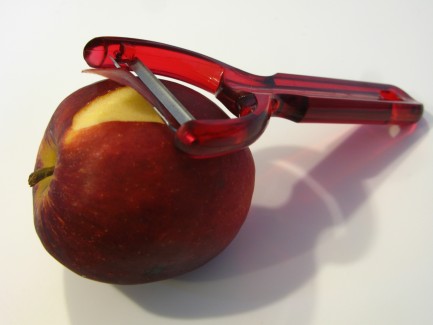
Italians peel fruits and vegetables normally enjoyed with the skin on in other countries: apples, pears, sometimes peaches, carrots, cucumbers, potatoes; even they don’t know exactly why. I’ve heard, “It’s healthier,” “The pesticides will make you sick if you don’t,” and “It tastes better, ” but I think it’s mostly tradition. And why peelers are sold in Italy, Italians prefer good old-fashioned knives. If you eat unpeeled produce in front of them, they might just take it out of your hand, remove the skin in one perfect spiral, and slice it into uniform wedges with the speed and dexterity of a sushi chef. In fact, one of my most embarrassing moments (and I have a lot to choose from) was trying to peel a pear at the dinner table while my Italian friend’s parents watched. Still, many people prefer their fruit with the skin on, they just wash it before eating it!
7. Italian condiments: don’t ask for salad dressing
…reach for the olive oil and vinegar. If you want to be pointed in the direction of the salad dressing aisle at the grocery store, you’ll get blank looks (because there isn’t one). Some tourist restaurants have “ranch” and “french dressing,” which taste like anything but ranch and french dressing. It’s best to begin an amateur mixologist career, by finding the perfect balance of oil and vinegar for your palette. Sound a little boring? You probably haven’t tasted authentic Italian olio e aceto (oil and vinegar); the varieties are endless and the flavors intense. Opt for a cloudy, green oil and pay a little extra for an aged, balsamic vinegar, and you might just write off other (less healthy) dressings for life.
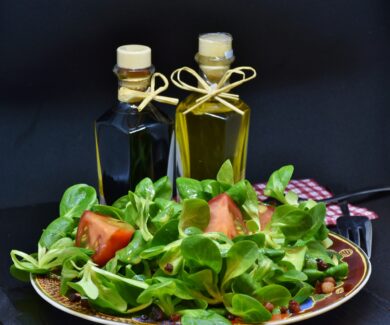
8. Use condiments sparingly
Olive oil is the only real Italian condiment. All the rest came from some other place and show up at grocery stores on the same shelf as exotic food. But “exotic” will not be the word Italians use to describe you putting ranch dressing on your pizza to their friends. People in Italy like to enjoy the exceptional flavor of what they’re eating (which is usually handmade or picked that day), and not mask it with other toppings. If they’re eating chicken, they want to taste chicken, not just barbecue sauce. A condiment (read: olive oil) should enhance flavors, never cover them up.
9.How do Italians eat? Take time to enjoy your food
To eat in Italian. Eating is not a race, and a bowl of cereal in front of late-night TV is not a dinner. It’s not uncommon for Italians to spend an hour preparing a meal and even more time savoring every bite. And when eating out: service is slow, courses are many, and it’s highly unlikely that a waiter will ever tell you they “need your table.” Block off large chunks of time in your agenda for eating. Italian food is unbelievably good and so worthy of “wasting” a few hours; sitting at a table is so much nicer than running around town with a sandwich in your hand. Relax! You’re in Italy!
There’s even an official expression for “enjoy your meal” in Italian, which is “buon appetito”.
10. Wait to eat plain bread with your meal
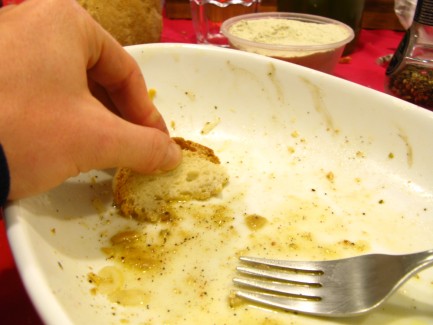
Can’t wait to show Italy how Italian you are by sitting down at your first ristorante, pouring some olive oil and vinegar on your plate, sprinkling it with Parmesan cheese and dipping your bread inside? Save it for the Olive Garden, because, like that restaurant, it’s actually not Italian at all. Visitors to Florence often complain about the flavor of plain Tuscan bread, as it’s made without salt. Now the big question is how to eat bread in italian restaurants? Well, you’ve got to see it more as a utensil, just like the Italians. It’s often used as the main tool to fare la scarpetta (do the little shoe): the action of mopping up any delicious-ness left on your plate after a meal, or whatever your fork can’t pick up during one.
*Interesting fact: Fare la scarpetta (do the little shoe) ‘s origin came from one of three things: 1) An old word similar to “scarpetta” that was used to describe someone who didn’t have enough food 2) That bread picking up food off a plate is similar to they way the sole of a shoe picks up things off the ground 3) That using bread to scrape up food off a plate smashes it into a shape that somewhat resembles a shoe. (I choose to believe #3 because of this video). Also, our Italian readers (Ciao, belli!) want me to warn you that while the scarpetta is 100% welcome at home, it’s arguably not the most polite demonstration at nice restaurants or in front of people you care about impressing.
Help us all be more Italian! What strange or fascinating food rules have you encountered in Italy? Share them in the comments below:
Extra point cause it’s called 10 rules, and this way I don’t break the post title
What time do Italians eat dinner?
A lot of you are wondering online, what time do Italians eat dinner? Well, generally around 8.30 pm, but that really depends on the family. Dinner time in Italy depends also on the area you’re in: in the north, they eat earlier, while in the south much later. Personally, I range between 8.30 and 9.30 pm. That’s because I usually wait until I’m hungry. Some of you might think that 8.30 is pretty late, but keep in mind what time Italians eat lunch: between 1.00 pm and 2.00 pm, considering that they don’t just have a sandwich or a salad but a real meal. Then, maybe around 4 or 5, they’ll grab any kind of snack, which could be a yogurt, fruit, a little sandwich, some cracker, etc. so they won’t be starving when dinner comes around.
Is it expensive to eat in Italy?
Well, that really depends on where you find yourself, and if you give off a touristy vibe. Now if you’re okay with not eating with a view of the Duomo, or the Canal Grande, you’ll definitely find some spots that are cheap and are also going to remind you the most of Nonna’s cooking. I mean I was just in Naples and ate in this side street, with nothing to look at except for the food. I had pasta, meat, wine, and dessert. I spent 15€. And it was all good. Just be wary of places that offer you a similar deal but with a view of the Duomo of Milan, cause you’re probably going to eat something you could’ve gotten at the Garden State Plaza food court.
Is it rude to not finish your food in Italy?
This is a trick question. But I shall answer it nonetheless. So, if you’re at a restaurant, no it isn’t rude at all. I mean, you ordered it, maybe it wasn’t what you expected, maybe you wanted all the food on the menu cause everything looked great, and now you’re stuffed. You can take it home to where you’re staying no worries. But if you’re at Nonna’s or at any family gathering, yes you will be rude for not finishing your food.
Restaurant = OK to not finish
Family Gathering = Don’t you dare.
Is the food safe to eat in Italy?
That is a pretty fair question. Italy has some of the strictest food regulations out there. So, yes it’s very safe to eat in Italy. Most regulation is put in place so the fame of Italian cuisine doesn’t get tarnished by crooked business owners that try to cut costs, and serve unhealthy food to unsuspecting consumers. When you’re visiting, don’t worry, the food is safe to eat in Italy.


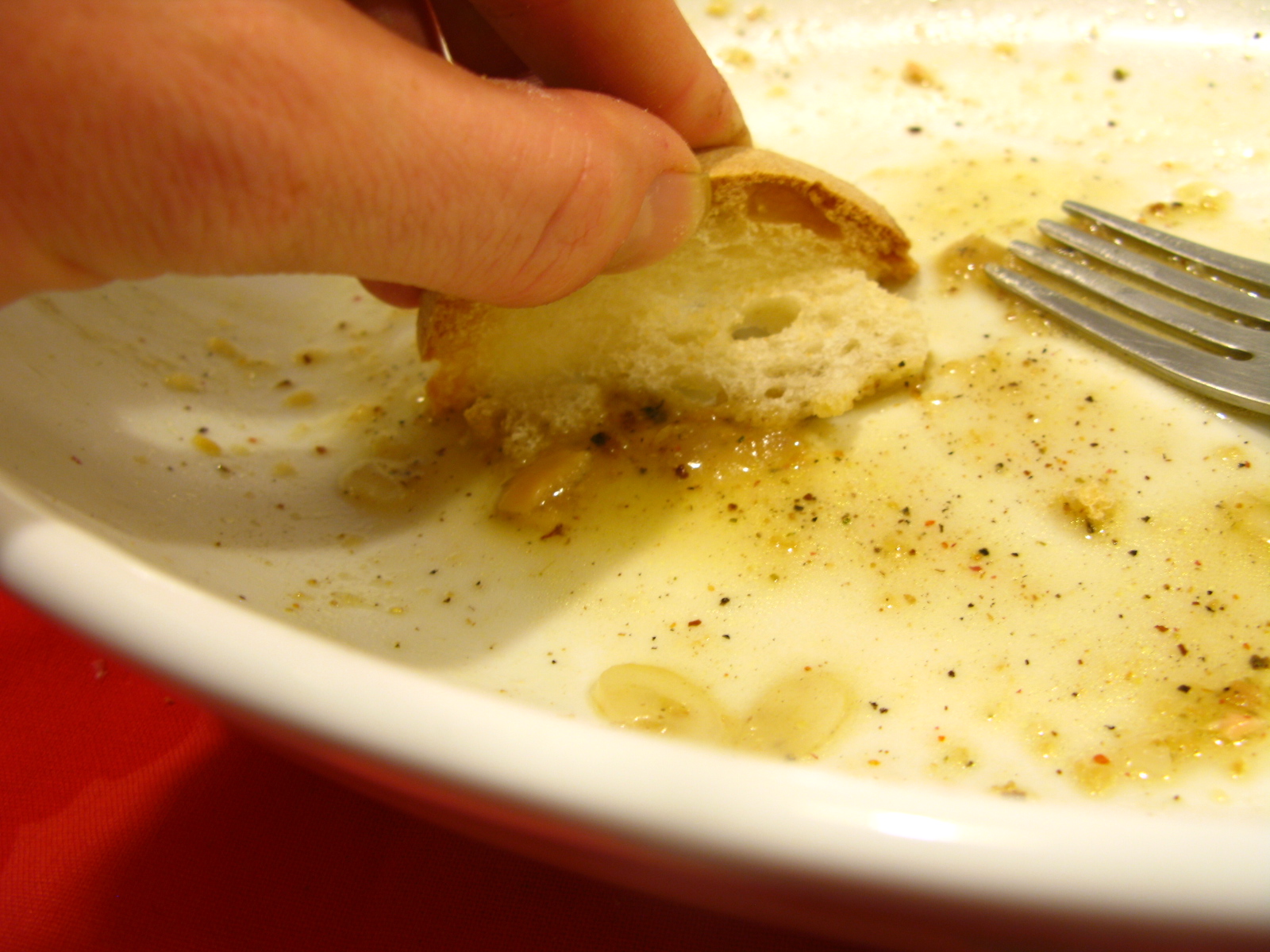





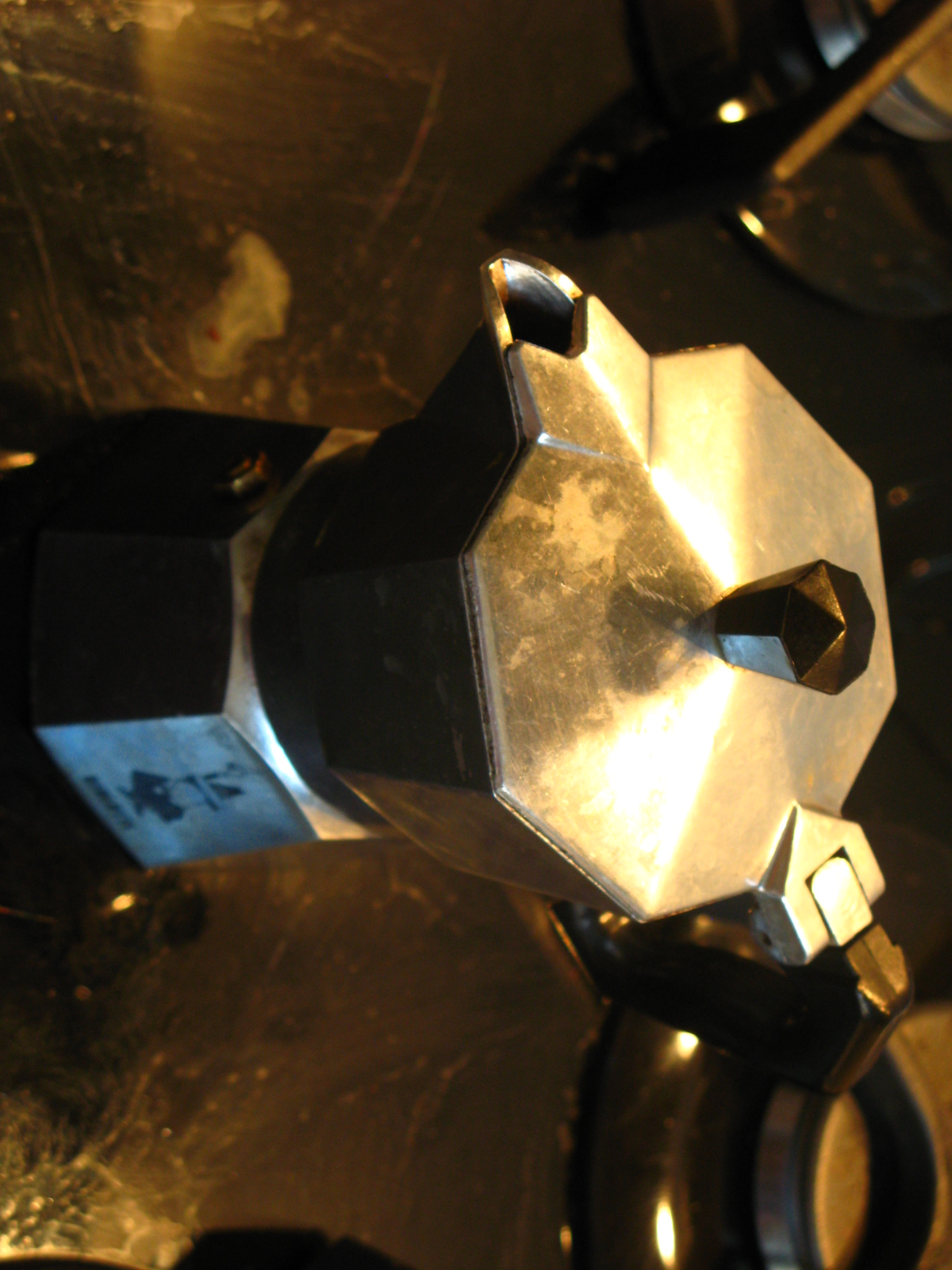


Ines Di Lelio THANK YOU for serting this poorly informed author straight. We have enjoyed your family’s restaurant several times and will be there anytime we are in Roma.
Very well written and pretty accurate, good job 👍
NEVER ASK FOR LEFTOVERS TO TAKE HOME OR DOGGIE BAGS. Un peccatto!!!
All the real Italians left Italy and came to America
[…] How to eat in Italy without scaring the italians […]
[…] but we got a whole list for you waiting on another page so you if you want to eat in Italian and don’t want to freak out the Italians while you’re […]
Everything in your article matches my experience of Italian travel. On my first trip I spent two weeks on my own exploring Abruzzi. Getting to a mountain village and asking for a place to eat and drink was priceless. I did what I could with the language and the people loved that I tried. The only phrase I rehearsed was asking for half a liter of local red wine. I got great wine and new friends as a result.
You need to explain the Italian meal served just after noon to 3:30 pm is like an American dinner. The evening meal in Italy at 8:30 pm or later is lighter food more like our American lunch.
Eating is inexpensive in Italy. I had a pranzo veloce quick lunch at an ocean front bistro in San Benedetto Del Tronto three years ago, a four course lunch for under 20 Euros. Impossible to eat like that here. Foods in the US are becoming so expensive. A cheapest burger with fries at The Habit Burger tge other day cost me nearly ten bucks.
HISTORY OF ALFREDO DI LELIO CREATOR IN 1908 OF “FETTUCCINE ALL’ALFREDO” (“FETTUCCINE ALFREDO”), NOW SERVED BY HIS NEPHEW INES DI LELIO, AT THE RESTAURANT “IL VERO ALFREDO” – “ALFREDO DI ROMA” IN ROME, PIAZZA AUGUSTO IMPERATORE 30
With reference to your article I have the pleasure to tell you the history of my grandfather Alfredo Di Lelio, who is the creator of “Fettuccine all’Alfredo” (“Fettuccine Alfredo”) in 1908 in the “trattoria” run by his mother Angelina in Rome, Piazza Rosa (Piazza disappeared in 1910 following the construction of the Galleria Colonna / Sordi). This “trattoria” of Piazza Rosa has become the “birthplace of fettuccine all’Alfredo”.
More specifically, as is well known to many people who love the “fettuccine all’Alfredo”, this famous dish in the world was invented by Alfredo Di Lelio concerned about the lack of appetite of his wife Ines, who was pregnant with my father Armando (born February 26, 1908).
Alfredo di Lelio opened his restaurant “Alfredo” in 1914 in Rome and in 1943, during the war, he sold the restaurant to others outside his family.
In 1950 Alfredo Di Lelio decided to reopen with his son Armando his restaurant in Piazza Augusto Imperatore n.30 “Il Vero Alfredo” (“Alfredo di Roma”), whose fame in the world has been strengthened by his nephew Alfredo and that now managed by me, with the famous “gold cutlery” (fork and spoon gold) donated in 1927 by two well-known American actors Mary Pickford and Douglas Fairbanks (in gratitude for the hospitality).
See the website of “Il Vero Alfredo”.
I must clarify that other restaurants “Alfredo” in Rome do not belong and are out of my brand “Il Vero Alfredo – Alfredo di Roma”.
The brand “Il Vero Alfredo – Alfredo di Roma” is present in Mexico with 2 restaurants (Mexico City and Puebla) and 2 trattorias (Mexico City and Cozumel) on the basis of franchising relationships with the Group Hotel Presidente Intercontinental Mexico.
The restaurant “Il Vero Alfredo” is in the Registry of “Historic Shops of Excellence – section on Historical Activities of Excellence” of the Municipality of Roma Capitale.
Best regards Ines Di Lelio
IN ITALIANO
STORIA DI ALFREDO DI LELIO, CREATORE DELLE “FETTUCCINE ALL’ALFREDO” (“FETTUCCINE ALFREDO”), E DELLA SUA TRADIZIONE FAMILIARE PRESSO IL RISTORANTE “IL VERO ALFREDO” (“ALFREDO DI ROMA”) IN PIAZZA AUGUSTO IMPERATORE A ROMA
Con riferimento al Vostro articolo ho il piacere di raccontarVi la storia di mio nonno Alfredo Di Lelio, inventore delle note “fettuccine all’Alfredo” (“Fettuccine Alfredo”).
Alfredo Di Lelio, nato nel settembre del 1883 a Roma in Vicolo di Santa Maria in Trastevere, cominciò a lavorare fin da ragazzo nella piccola trattoria aperta da sua madre Angelina in Piazza Rosa, un piccolo slargo (scomparso intorno al 1910) che esisteva prima della costruzione della Galleria Colonna (ora Galleria Sordi).
Il 1908 fu un anno indimenticabile per Alfredo Di Lelio: nacque, infatti, suo figlio Armando e videro contemporaneamente la luce in tale trattoria di Piazza Rosa le sue “fettuccine”, divenute poi famose in tutto il mondo. Questa trattoria è “the birthplace of fettuccine all’Alfredo”.
Alfredo Di Lelio inventò le sue “fettuccine” per dare un ricostituente naturale, a base di burro e parmigiano, a sua moglie (e mia nonna) Ines, prostrata in seguito al parto del suo primogenito (mio padre Armando). Il piatto delle “fettuccine” fu un successo familiare prima ancora di diventare il piatto che rese noto e popolare Alfredo Di Lelio, personaggio con “i baffi all’Umberto” ed i calli alle mani a forza di mischiare le sue “fettuccine” davanti ai clienti sempre più numerosi.
Nel 1914, a seguito della chiusura di detta trattoria per la scomparsa di Piazza Rosa dovuta alla costruzione della Galleria Colonna, Alfredo Di Lelio decise di aprire a Roma il suo ristorante “Alfredo” che gestì fino al 1943, per poi cedere l’attività a terzi estranei alla sua famiglia.
Ma l’assenza dalla scena gastronomica di Alfredo Di Lelio fu del tutto transitoria. Infatti nel 1950 riprese il controllo della sua tradizione familiare ed aprì, insieme al figlio Armando, il ristorante “Il Vero Alfredo” (noto all’estero anche come “Alfredo di Roma”) in Piazza Augusto Imperatore n.30 (cfr. il sito web di Il Vero Alfredo).
Con l’avvio del nuovo ristorante Alfredo Di Lelio ottenne un forte successo di pubblico e di clienti negli anni della “dolce vita”. Successo, che, tuttora, richiama nel ristorante un flusso continuo di turisti da ogni parte del mondo per assaggiare le famose “fettuccine all’Alfredo” al doppio burro da me servite, con
l’impegno di continuare nel tempo la tradizione familiare dei miei cari maestri, nonno Alfredo, mio padre Armando e mio fratello Alfredo. In particolare le fettuccine sono servite ai clienti con 2 “posate d’oro”: una forchetta ed un cucchiaio d’oro regalati nel 1927 ad Alfredo dai due noti attori americani M. Pickford e D. Fairbanks (in segno di gratitudine per l’ospitalità).
Desidero precisare che altri ristoranti “Alfredo” a Roma non appartengono e sono fuori dal mio brand di famiglia.
Il brand “Il Vero Alfredo – Alfredo di Roma” è presente in Messico con 2 ristoranti (Città del Messico e Puebla) e 2 trattorie (Città del Messico e Cozumel) sulla base di rapporti di franchising con il Group Hotel Presidente Intercontinental Mexico.
Vi informo che il Ristorante “Il Vero Alfredo” è presente nell’Albo dei “Negozi Storici di Eccellenza – sezione Attività Storiche di Eccellenza” del Comune di Roma Capitale.
Grata per la Vostra attenzione ed ospitalità nel Vostro interessante blog, cordiali saluti
Ines Di Lelio
and salads are not served first.
Usually, the salads are a main dish. When you order one they come in huge bowls, plus they don’t want to ruin your appetite before feasting on some amazing Italian food.
Restaurants stay open very late. You can still go in at 10pm and get seated.
True and that is one of the best things about restaurants here, after the food. Cause you might be out visiting things all day and loose track of time, lucky for you you’ll still find a seat!
Fun and informative article but if you had asked your Roman friends about Alfredo you might have heard how Alfredo di Lelio riffed on fettuccine al burro by emulsifying fresh parm into it to stimulate his pregnant wife’s appetite.
The use of cream in America was due to the fact that good parmesan cheese was not obtainable so restaurants improvised.
Adding chicken probably originated in H#ll.
As you well know, Italy has no “one cuisine”. It is highly regional and incredibly diverse. Try ordering pizza in Piemonte or fonduta in Naples and you will see this graphically illustrated!
Still a fun and informative article.
Italy has indeed some of the most unique cuisines, but thanks for the info on Alfredo di Lelio, because I didn’t have clue before now!
I’m Italian, I can say that you described all the Italian habits quite well 😊 good job!!
Thanks Ellen 😊😊
Another food rule from the Polizia d’Italiano Mangia (Italian Food Police)
Never eat cheese with seafood! Italy has an enormous Mediterranean coastline an abundance of seafood and shellfish, hence the prevalence in their cuisine. Italians believe cheese masks the delicate flavor of Fruitta di Mare, so no shrimp parmigiana!
That’s almost as bad as the Peccato Originale 😳😳😳😳😳
Are you Italian?? Most of what you say may be your experience but is not correct As a whole
I completely agree with your statement. I am Italian and these really have not been my experiences (except cheese with seafood, polpettes, and peeling fruit). Most anywhere toy go for that “Italian Experience🙄” Will indulge American palettes. Especially if you’re traveling with children.
Yes, they will accomodate but that’s not the traditional, Italian way of eating. This article is fairly accurate 🇮🇹
I love your article , especially about peeling fruit. I see my Grandfather, like it was yesterday, peeling his fruit. Brings back allot of memories. Food in an Italian home is what love is all about. I wrote down all my Mother’ s recipes as She was cooking and I cook them today. I’m a guy , love to cook and remember it was a job to write down those recipes as my Mom cooked. My Mom never measured and the food was great. I learned and do it the same way. Sorry to say all my Grandparents have passed on as have my Mom and Dad. Lots of great memories.
Frank so true I can hear my Nona tsk tsking me for biting into my apple..I have the best eating habits thanks to her, we are from Northern Italy so lots of vegetables…I like you miss them so very much.
I like what you said about using olive oil and vinegar if you want to eat salad in the authentic Italian style. My sister has been telling me about how she wants to try eating more Italian food in the coming year. I’ll share this information with her so that she can look into her options for restaurants that can help her with this.
That’s great, plus eating Italian style is really healthy! I hope your sister enjoys the article, also you both could enjoy this other food-related post on all the different varieties of food in Italy divided by region.
[…] defo know how important food and the culture around it is here in Italy, and sometimes you’ll find yourself in some situations where the […]
Like it all except the last one. In Naples, the bread is made with salt. Neapolitans are quite disdainful of Roman bread, which is made without salt, for this reason. Still used like a utensil, but a delicious, delicious utensil – because it was made with SALT! 😉
I’ll have to agree with you on that one, Katrina. I would also prefer a delicious utensil over a normal one 🙂
In Rome we add salt in our bread. You are mistaken with Florence. Lazio region has some of the best bread in Italy. Salt provides flavor. Don’t be like my American in-laws, they criticize when I add salt cooking for them and then they have bags of potato chips at home. LOL! Italian food is about simplicity and flavor, potato chips not needed.